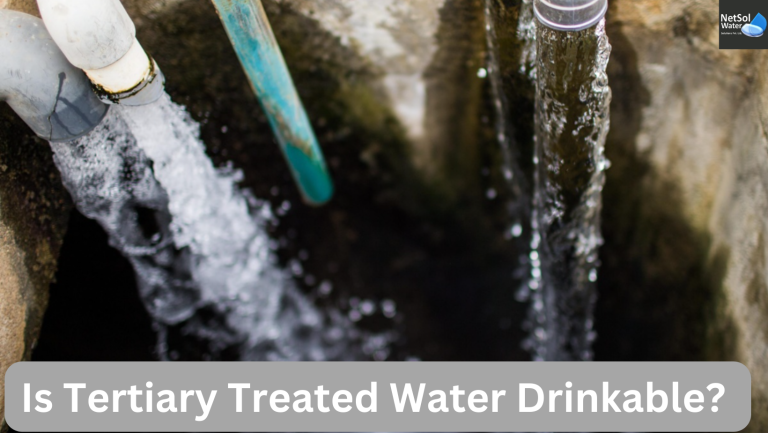
The response to this is an obvious YES! You can drink the recycled water coming from the tertiary stage of Sewage treatment plants if properly treated. Mostly when people hear about sewage treatment plant, they think of all the domestic waste water going from our kitchen sinks, bathroom, washrooms etc. with the thought of sewage being filthy and the water after being treated see them as filthy as well. But that’s not the case always. Many people across the country utilizes the treated sewage water even for agricultural & farming purposes, commercial, & industrial purposes. Therefore, it can be derived that drinking water is recycled from the treated sewage waste water. Is tertiary treated water drinkable.
Plants in the waste water treatment sector frequently focuses on primary & secondary treatments, which handle the majority of the job of readying waste water for discharging in to the environment . Tertiary level of care is also crucial in most cases . It gives an assurance that the treated wastewater is clean, hygienic, in compliance with standards set by the Governments, & suitable for drinking or re-use. So lets Discuss Is tertiary treated water drinkable.
On a larger part, waste water treatment systems have at least two levels , primary & secondary treatment procedures, as well as some extra preparatory approaches. Physical techniques such as filtering & settling are used to remove grit, debris, oil, grease, & certain lighter materials in primary treatment, which generally removes 50% to 70% of the suspended solids in wastewater. Secondary treatment employs additional biological processes such as aeration & activated sludge treatment to degrade dissolved & suspended bio solids through the use of beneficial bacteria.
Usually for general purposes of treatment does not include tertiary level of treatment. Here , Tertiary stage of treatment therapy adds to the third level, the more sophisticated, & stringent degree of care. Primary & secondary treatment often produce waste water that is only clean enough to be safely discharged into the environment. Tertiary treatment, on the other hand, can attain water purification levels that allow the water to be re-used in water-intensive activities or even as drinking water. Tertiary Treatment is said to be final stage in the waste water treatment facilities like Sewage Treatment plants(STPs) & Effluent Treatment Plants(ETPs) where most of the contaminants to the micro level is eliminated from the water. This stage being the last stage expels out many of the remaining particulates, forced to disinfection with chlorination & removes various salts remaining.
Commercial Ro Plant is the best manufacturer of water treatment plants in all over India.
But to obtain the water (that is the recycled water) which is considered suitable for drinking is extensively purified thoroughly by water treatment plants with the apparatus using the reverse osmosis(RO) techniques. The water procured from the tertiary stage is generally mixed to the groundwater or the water on surfaces(rivers , lakes , ponds) for the further processing. The water that is acquired here after further purification finally becomes clean , safe & secured for the consumptive purposes.
Figure 1 Tertiary Waste Water Treatment Processes

The Tertiary waste water treatment often employs a combination of physical as well as chemical techniques to eliminate potentially dangerous micro-biological pollutants from waste-water. Filtration is often followed by further disinfection treatment. Tertiary treatment may also include other specialist treatments such as lagoon storage(lagooning) , biological nutrient removal , & nitrogen & phosphorus removal in specific circumstances .
- Filtration by filters : Tertiary filtering components can be made of a variety of materials. Filters commonly use sand & activated carbon , although they can also use fine woven fabric. Bag filters, drum filters , & disc-filters are among the several types of filters available.
- Disinfection by Chlorination , Ozonation , UltraViolet :
Chlorination –
Because it is relatively cheap, easy to use, & highly efficacious, chlorine is one of the most often used disinfectants in wastewater treatment. To destroy unwanted microorganisms such as bacteria & viruses, wastewater treatment plants might discharge chlorine into the wastewater. Because chlorine may affect aquatic habitats, chlorinated effluent must be dechlorinated before being discharged into the environment. When chlorine combines with organic matter, it can occasionally produce potentially carcinogenic chemicals such as tri-halo-methanes & mutagens .
Ozonation:
As an alternative, ozone(O3) — a chemical created by applying electrical energy to add a third oxygen atom to conventional diatomic O2 — can be used as a disinfectant. Ozone is a highly reactive gas that may kill the majority of microorganisms it comes into contact with. It is safer than chlorine since facilities may create it on-site as needed rather than storing it and risking a harmful leak over time. It will also not produce any dangerous byproducts in the water. The treatment equipment, on the other hand, is quite expensive to maintain.
UltraViolet :
In tertiary stage of treatment, ultraviolet(UV) light is a frequent disinfectant. The wastewater travels through banks of UV lamps, which sterilize bacteria by causing genetic damage. Although ultraviolet radiation does not normally kill viruses and bacteria, it does render them incapable of infecting people or wildlife. However, the effluent must have been aggressively treated earlier, since any leftover organic debris might protect the microbes from the UV light. The lighting also needs a high level of servicing & maintenance.
- Discharge : After tertiary treatment, the effluent is suitable for disposal back into the environment. Many localities have specified discharge criteria for treated water, and tertiary treatment should be adequate to fulfill those standards, maintain the environment clean, & protect human health.
- Re-Use : Many treatment plants utilize tertiary treatment to ensure that the water is safe for human consumption. The water has been sufficiently purified as a result of tertiary treatment to be safe to drink. Tertiary-treated water is also suited for a wide range of applications that require clean water, including industrial & manufacturing processes, oil and gas extraction & refining, utility cooling, & agricultural techniques like as irrigation.
If anyone wants to explore the world of treatment plant systems for a commercial RO plant, or any types of water treatment plants like an Industrial RO plant (which is a sub-type of commercial RO plant), WTPs , ETPs, STPs , then Netsol Water is the best company for the manufacturing of these . The most reliable , the most trusted manufacturer and a consultancy venture NetSol Water provides a grand solution for almost most of the problems regarding water , and waste water treatments . So these the factors we can say Is tertiary treated water drinkable. And the answer is Yes.
